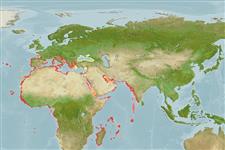>
Carangiformes (Jacks) >
Carangidae (Jacks and pompanos) > Trachinotinae
Etymology: Lichia: Greek, lichia = corpse like skin colour.
More on author: Linnaeus.
Environment: milieu / climate zone / depth range / distribution range
Ökologie
seewasser; brackwasser; ozeanodrom (Ref. 51243); tiefenbereich 0 - 50 m (Ref. 3197). Subtropical; 47°N - 28°S
Eastern Atlantic: southern Bay of Biscay to South Africa, including the Mediterranean. Western Indian Ocean: South Africa to Maputo Bay, Maputo (Mozambique)..
Length at first maturity / Size / Gewicht / Alter
Maturity: Lm ?, range 60 - ? cm
Max length : 200 cm TL Männchen/unbestimmt; (Ref. 57392); common length : 100.0 cm TL Männchen/unbestimmt; (Ref. 3197); max. veröff. Gewicht: 50.0 kg (Ref. 27584)
Rückenflossenstacheln (insgesamt) : 8; Rückenflossenweichstrahlen (insgesamt) : 19 - 21; Afterflossenstacheln: 3; Afterflossenweichstrahlen: 17 - 21. Diagnosis: body elongate, moderately deep and compressed; dorsal profile of head almost straight, ending in a pointed snout; eyes relatively small; upper jaw slender and rounded posteriorly, ending below or beyond posterior eye margin; 2 dorsal fins, 1st with 7 spines with only their bases connected by a membrane, 2nd with 1 spine and 19-21 soft rays; anal fin with 2 detached spines followed by 1 spine and 17-21 soft rays; pectoral fins short, comprised 1.5-1.8 times in head length; scales small, those on breast oval to strongly lanceolate, and partially embedded in the skin; lateral line very irregular and wavy, describing a convex curve over, and a concave curve behind pectoral fins; no lateral-line scutes (Ref. 57392). Brown above, silvery white below lateral line; lobes of dorsal and anal fins black distally; juveniles (to at least 12 cm fork length) with brownish black bars on sides (Ref. 3197, 57392).
Marine, coastal pelagic species (Ref. 57392). Adults are found in coastal waters including estuaries. Occasionally entering lower reaches of rivers like the Kunene and Orange Rivers in Namibia (Ref. 52863). Juveniles often entering estuaries (Ref. 57392). Feed mainly on fish; juveniles prefer crustaceans (Ref. 4332). Eggs are pelagic (Ref. 4233). Popular game fish (Ref. 3197).
Smith-Vaniz, W.F., 1986. Carangidae. p. 815-844. In P.J.P. Whitehead, M.-L. Bauchot, J.-C. Hureau, J. Nielsen and E. Tortonese (eds.) Fishes of the north-eastern Atlantic and the Mediterranean. UNESCO, Paris. vol. 2. (Ref. 4233)
IUCN Rote Liste Status (Ref. 130435)
Bedrohung für Menschen
Harmless
Nutzung durch Menschen
Fischereien: kommerziell; Sportfisch: ja
Tools
Zusatzinformationen
Download XML
Internet Quellen
Estimates based on models
Preferred temperature (Ref.
123201): 16.2 - 29, mean 26.3 °C (based on 478 cells).
Phylogenetic diversity index (Ref.
82804): PD
50 = 1.0000 [Uniqueness, from 0.5 = low to 2.0 = high].
Bayesian length-weight: a=0.01349 (0.00996 - 0.01827), b=2.94 (2.85 - 3.03), in cm total length, based on LWR estimates for this species (Ref.
93245).
Trophic level (Ref.
69278): 4.5 ±0.8 se; based on diet studies.
Widerstandsfähigkeit (Ref.
120179): mittel, Verdopplung der Population dauert 1,4 - 4,4 Jahre. (Assuming tm=2).
Prior r = 0.51, 95% CL = 0.34 - 0.76, Based on 1 data-limited stock assessment.
Fishing Vulnerability (Ref.
59153): Very high vulnerability (90 of 100).
Climate Vulnerability (Ref.
125649): High vulnerability (57 of 100).
Nutrients (Ref.
124155): Calcium = 36.6 [20.7, 79.3] mg/100g; Iron = 1.26 [0.69, 2.33] mg/100g; Protein = 20.5 [19.3, 21.7] %; Omega3 = 0.346 [0.200, 0.608] g/100g; Selenium = 24.1 [12.4, 44.8] μg/100g; VitaminA = 9.68 [2.53, 33.46] μg/100g; Zinc = 0.526 [0.372, 0.751] mg/100g (wet weight);
